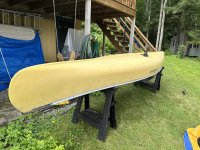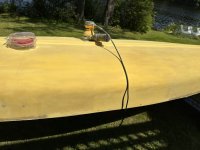Not sure you understand where i am at. It's a used canoe with a good hull, no fiberglassing except the flotation at both ends. The thwart in the middle of the canoe needs to be cut. What width? More than the canoe's width? Less?
MrPoling said:
I wouldn't stress over it, especially for fiberglass. I would just cut it to fit the canoe is it is.
RoyBrew also said:
If you still have the original seats, and how they mount, I would install them first. The after the seats are mounted, I would cut the thwart to fit. I wouldn't stress the width of the hull in any direction.
Froggio,
If you want to use the KISS principal, (Keep It Simple, Stupid!), following MrPoling's and RoyBrew's advice is sound. Most 16- to 17-foot recreational canoes I'm familiar with are designed with a center width at the gunnels (gunwales) at about 35 or 36 inches. That's measured to the outside of the actual hull, below the outwale portion of the gunnel, so that outwale would stick out some on each side and make the boat a little wider than the 35 or 36 inches. Cutting the length of the thwart to make the canoe that width (a quarter-inch or so less than the desired 35 or 36 inches or whatever you choose) is definitely close enough.
Notice that if you put the canoe on a flat concrete surface like a patio, sidewalk, or garage floor, that the center of the canoe probably contacts the floor and the ends of the boat sink a little, which narrows the width at center. If you put it on sawhorses that are closer to the ends of the boat, that would force the ends up a little (weight in the center forcing it down) which would make the hull wider in the center. Those would indicate different lengths of the thwart board to make the hull stay at that width.
I have no knowledge of your Nature Bound brand of canoe or which model it might be (if there was more than one?). If the designed keel line of the boat is straight, the whole length of the boat hull might contact the cement surface, which would be good for straight-ahead paddling, bad for maneuvering. Cut your thwart length appropriately. It probably doesn't matter much. If you don't like it, make another later. I'd agree again with MrPoling and question poplar as a good wood for that center thwart, but then I tend to single-carry my own canoes a lot. Meaning carrying it alone, no help, upside down with the center thwart across my neck, using it as a short-term yoke. I'd use 3/4" ash and shape it as you please for a stronger thwart for such duty. If you always will have help carrying the boat, the poplar would work, as long as you don't drop something heavy on it (a cooler?), or fall against it yourself. You've got the thwart. Cut it to a length and install it and try it and see how it works. If you have issues, make another, either poplar again, or ash, or cherry or oak, or whatever you like or have available.
Good luck with it and please report back as to how it works out for you.
Edited to add:
My limited experience doing this indicates that when thwarts are taken out of a canoe, the gunnels tend to try to straighten out some, meaning that the boat becomes narrower than designer intended. Installing the thwarts widens it again. If you have an older boat, the gunnels may have had some of that straightening effect worked out of them over time. Some? All? None? We need Mike McCrea in here as he's got a lot of experience with this stuff.
In any case, install your thwart temporarily then put the boat on the concrete garage floor and make sure that the ends aren't the only place touching the concrete. Boat center touching and the ends up a little bit, an inch or less, or at most the whole bottom end to end touching the concrete.
God, I'm making this complicated!!!


